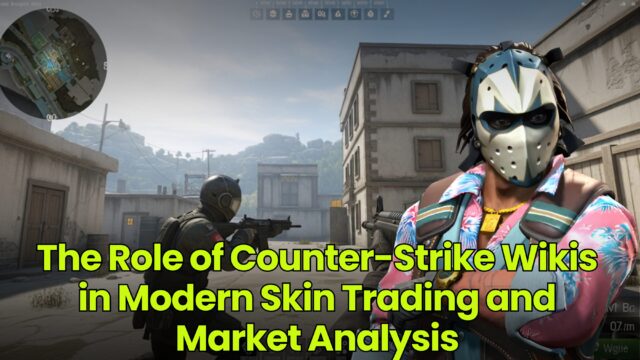The Role of Counter-Strike Wikis in Modern Skin Trading and Market Analysis
Skin trading in CS2 has evolved into a complex ecosystem that blends gaming with real-world economics. Traders seek the best items to buy and sell, but various factors influence the market, such as price fluctuations, rarity, and in-game updates....

Skin trading in CS2 has evolved into a complex ecosystem that blends gaming with real-world economics. Traders seek the best items to buy and sell, but various factors influence the market, such as price fluctuations, rarity, and in-game updates. These factors can often feel overwhelming.
Traditional methods of skin trading left players dealing with fragmented data, outdated prices, and unreliable visuals. This made the market unpredictable and risky. The counter strike wiki has transformed the landscape by offering a solution to these challenges.
From Static Lists to Strategic Tools: The Evolution of CS Wikis

In the early days of Counter-Strike, item databases were mostly static. They offered surface-level information: just skin names, collections, and perhaps a price range pulled from outdated sources. Traders had to jump between multiple tools and browser tabs to make informed decisions, which often led to missed opportunities or costly mistakes.
That landscape has drastically changed. Modern CS wikis, especially the resource powered by DMarket, act as real-time, data-driven hubs that provide everything a trader needs in one place. They’ve evolved from passive directories into strategic trading platforms that reflect the live market, including current listings.
What Modern Wikis Offer Traders Today
Modern CS wikis are no longer just reference pages. They’re packed with real-time data and advanced tools that unlock deeper market insights. Whether you’re flipping items or building a long-term portfolio, these platforms offer key features that shape smart decision-making.
Rare Patterns and Float Values
Not all skins are created equal. Two knives may share the same name, but differences in pattern seed, Float Value, or wear tier can make one exponentially more valuable than the other.
Today’s CS wikis help traders to instantly:
Identify special patterns (e.g., Case Hardened Blue Gems or Doppler Phase variants); Check Float Values and ranges; Filter listings based on item exterior or variant type.This level of granularity wasn’t possible before, and now it gives traders an undeniable edge.
ALSO READ: 10 Best New NFT Projects in 2025
Historical Price Data to Inform Trades
Impulse buys and panic sells are common in any fast-moving market. However, traders who analyze historical pricing data can identify patterns that the average player may overlook. The CS2 wikis provide valuable insights through visual graphs that display price fluctuations over different time frames, such as days, weeks, or months.
In addition to short-term fluctuations, such resources can highlight seasonal spikes, which often occur during operations or updates, as well as the long-term growth of retired skins and cases. By examining this data, users can determine whether they are simply chasing a hype wave or making a more strategic, informed investment.
Why Centralization Matters: The Power of DMarket’s CS2 Wiki
One of the biggest challenges for CS traders has always been tool fragmentation. You had to use one website to check skin details, another to analyze Float Values, and yet another to list or buy the item.
The CS2 wiki by DMarket solves that problem. This platform consolidates:
Skin descriptions; Wear values and pattern info; Real-time pricing from the DMarket marketplace; Direct buy/sell functionality.It removes the guesswork and unifies the entire trading process—from research to execution.
How Traders Use Wikis to Gain a Competitive Edge
Access to real-time pricing, Float Value data, and historical trends means more than just information—it means actionable strategy. Here’s how savvy traders use CS2 wikis to uncover hidden opportunities and maximize profit.
Case Study 1: Sniping Undervalued Skins
 A trader looking to flip an item sets filters in the CS2 wiki for Float Values under 0.03, prices below $25, and Covert or Knife items. They spot low-float AK-47 | Neon Rider listed 18% below the market average.
A trader looking to flip an item sets filters in the CS2 wiki for Float Values under 0.03, prices below $25, and Covert or Knife items. They spot low-float AK-47 | Neon Rider listed 18% below the market average.
After checking the historical price chart and confirming a temporary dip, the trader buys the skin and flips it a day later for a solid profit. This highlights how traders use wikis to identify undervalued skins and make informed decisions.
Case Study 2: Investing in Long-Term Rarity
Another trader uses the resource to analyze past prices of Operation-exclusive skins. The data shows consistent year-over-year appreciation. After spotting a lull in demand, they invest in several Operation Broken Fang skins. Six months later, prices surge after a new case drop renews interest in old collections.
The Wiki’s Role in Reducing Scams and Promoting Transparency
The prevalence of scams is a major challenge in virtual goods trading, especially in the high-value Counter-Strike skin market. The DMarket CS2 wiki helps mitigate this by consolidating accurate, verified information that traders can rely on.
By ensuring up-to-date data, high-quality visuals, and real-time price updates, the platform reduces the risk of falling for misleading listings or fraudulent sellers. The transparency it provides is leveling the playing field, which allows both new and experienced traders to make informed decisions. This trust is essential for fostering a healthier and more sustainable trading environment.

 Fransebas
Fransebas 



















![The 2026 AI Search Benchmark Every SEO Leader Needs [Webinar] via @sejournal, @lorenbaker](https://www.searchenginejournal.com/wp-content/uploads/2025/11/1-259.png)












